





Though few give much thought to pruning palms, it is a large source of income for some... and a constant source of aggravation for me. Palms are much simpler trees than most other trees one might need to trim, having no branches (rare exceptions)- just leaves on a pole. However it is amazing to me how often palms are either pruned improperly, unecessarily or even fatally. This article will cover some of the basics of pruning palms with some guidelines about when to prune, when not to, and what palms should or shouldn't be pruned from a health as well as artisitic point of view.
For the most part, palms are pretty low maintenance trees. Most species never ever need to be pruned... but then, most species are not used frequently in landscaping. Only about a dozen or so palms frequent the public landscaping, though the basic principles apply to your own, possibly different back yard palms as to the large public trees. The basic rule, prune only when necessary, sounds simple but is rarely followed. Economics, danger to the public and misconceptions rule most public palm pruning practices.
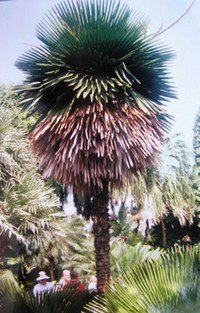
Rare species in cultivation, but this Copernicia macrogossa shows that sometimes palms look best if not pruned, even if they do form a large peticoat
I attended a palm conference about 5 years ago at the local arboretum. I was expecting my usual group of palm-nut friends to attend, but was surprised to find the placed packed with professional gardeners and landscapers- not a one of the local palm nuts came, as this was not that sort of meeting (not about the rare and ‘cool' things we have in our collections). This was about the practical care of landscape palms, including proper pruning practices. Everything the lecturer said made a lot of sense, but in reality I have hardly ever seen any of his recommendations followed.
Palms produce a leaf at a time, and once a full crown of leaves is achieved in a mature individual (for some palms this is just 4-5 leaves, while in other species, this can be over 120 leaves), every new leaf formed is followed by an old leaf dying. This number, unique to each palm, is the ideal number of leaves for that palm to have to grow optimally. Any less leaves than that number and the palm will grow sub-optimally, or slower. Sub-optimal numbers of fronds can weaken a palm, too, and make it more vulnerable to wind damage, parasites and fatal infections. For some reason there is a myth going about that pruning palms will speed up their growth rate. This is actually the opposite of what happens and I have no idea why this myth persists. In an ideal world, we would ONLY prune the dead or broken leaves off each palm.
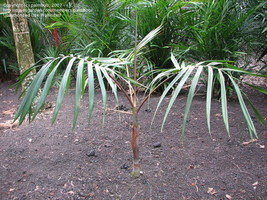
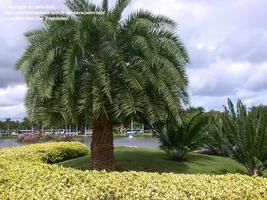
Actinokentia often only has 3-4 leaves at a time, while Phoenix loureirei will hold up to 100 at a time
Green palm leaves, or fronds, are the palms sole source of food (from photosynthesis). Fertilizer is NOT food, but a source of micronutrients the palm uses, along with water and sunlight to make its food. When green leaves are removed, the palm cannot make the ideal amount of food it needs to survive. Fortunately most palms are quite tolerant of this ‘abuse' and can deal with sub-optimal amounts of green leaves... up to a point. So there should be good reasons to prune palms ‘prematurely' as well as pruning in general.
•1. 1. Most palms are pruned to remove dead leaves that can be a source of hiding places for pests.
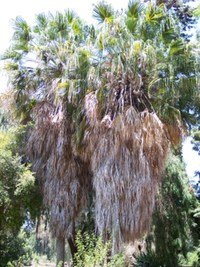
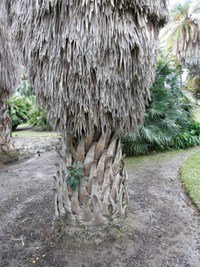
These Livistona australis and Brahea armata peticoats of dead leaves are great places to hide all sorts of unwanted animal life
•2. 2. To decrease the potential hazards of fire (dead frond burn extremely easily- this is an actual adaptation palms have developed, though, in nature. The dead palm leaves burn off rapidly, removing the potential pests, but burn so rapidly little if any damage is done to the healthy green leaves at the top).
•3. 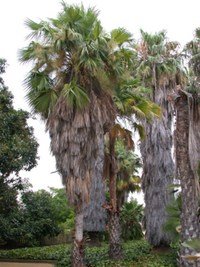 Dead fronds will burn nearly instantly and can be fire hazards near homes
Dead fronds will burn nearly instantly and can be fire hazards near homes
3. To decrease the potential hazard to humans (dead palm fronds can fall at any time)- some are quite heavy and some have sharp spines/edges (the legal ramifications are many). This potential hazard often requires pruning of healthy green fronds as well, as some large palms have leaves that protrude out into public walkways, and some are heavily armed so that even ‘brushing' by one can result in serious injury.
•4. 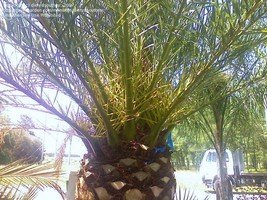
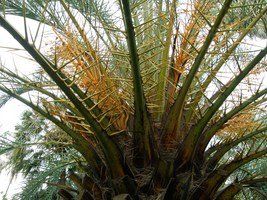
Note the sharp spines at the base of these Phoenix canariensis and Phoenix theophrasii leaves- right at eye level! Photo on left by diehrdsouthrnr
4. To decrease the weed potential of some palms- King palms (Archontophoenix ) and Queen palms (Syagrus romanzoffiana) are extremely prolific seed/fruit producers and their dropped seeds can lead to troublesome weed problems below, as well as cause dangerous pedestrian situations with thousands of ‘marble-like' seeds to walk through. Seed production and falling rotten fruit can also potentially damage automobiles and gum up the bottoms of people's shows, subsequently ruining carpeting or staining floors and sidewalks. During the expensive process of removing inflorescences (flowers), some leaf pruning is done simultaneously to save money.
•5. 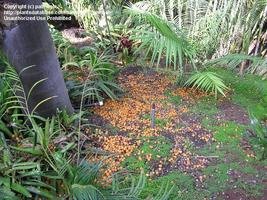
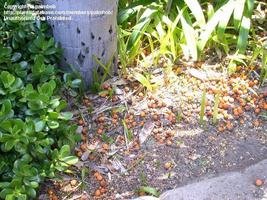
Queen palm seeds fall in massive numbers if the infructescences are trimmed off, leading to a 'lawn' of seedlings sometimes
5. Removing inflorescences can also improve the strength of the palm as it can save its energy for growth and health and less on seed production.
•6. 6. Palms are often pruned to clear visual paths for safety reasons (so one can see signs, traffic, pedestrians etc.)
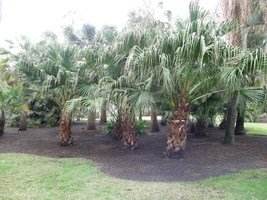
Livistona chinensis pruned to allow traffic below/beside them, and clearing a visual path as well
•7. 7. To decrease damage to nearby structures (power lines, buildings etc.) that can be affected by the leaves falling or blowing about in the wind. But despite common dogma, pruning palms does NOT improve their ability to tolerate high winds... in fact, just the opposite is true- overpruning palms leaves the remaining leaves more prone to wind damage

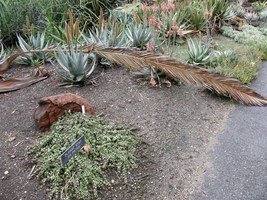
following a wind storm the ground can be littered with huge amounts of debris, potentially damaging cars and pedestrians below. Probably these should have been pruned off
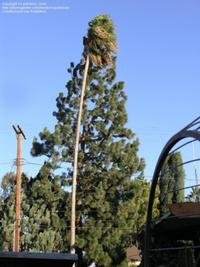

These shots of Washingtonias in high winds (nearly 70mph) show that they have no problems with high winds despite their normal full crowns
•8. 8. Some pruning of leaves may be necessary when transplanting palms. For example, some Sabals transplant best when ALL their leaves are removed (this seems to be ONLY true for members of this genus- don't try this with any other genera of palms). Some pruning of at least some of the leaves and parts of others is thought to decrease moisture loss from transpiration while these palms are in conditions that prevent them from absorbing water from their traumatized roots.
•9. 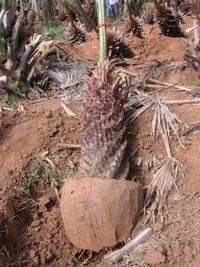
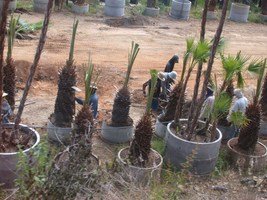
Sabal palmetos with hurricane cuts in preparation for moving- this genus is unique in toleratint this severe a pruning
9. Some palms are pruned for economic reasons. Date palms, if not pruned, become unmanageable, difficult to maneuver around, and don't tend to produce fruit as reliably.
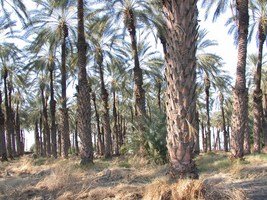
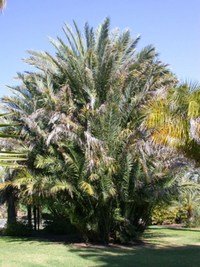
Field of date palms used for commercial production on left, and a single, unpruned palm on the right
10. Lastly, for appearance. Many find large petticoats of dead fronds unappealing. But also some find the normal mass of leaves some suckering palms produce (such as in the case of Chamaerops species) to be less than attractive, particularly when compared to the industry standard of clean trunks topped with a smaller group of leaves. And some like the weird ‘pineapple' look of newly pruned Canary Island Date Palms (Phoenix canariensis) over the more natural look of a large drooping canopy of 150 or more leaves these massive palms can support. This pruning often involves the ‘necessity' of cutting off green leaves which weakens the palm, but if done judiciously, is not usually a serious health concern. See more about this last situation below.
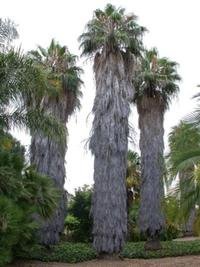

Some like the full skirt look, but most prefer the skinny, naked pole look of Washingtonias
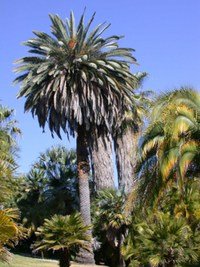
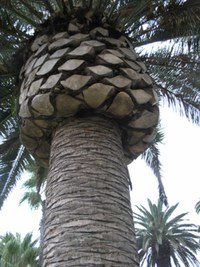
Phoenix canariensis has a very ornamental full crown of leaves, but some prefer this 'pineapple cut'
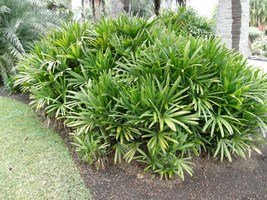
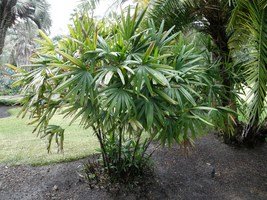
Rhapis palms growing like a hedge... but if pruned to reveal the stems, these plants suddenly become more elegant
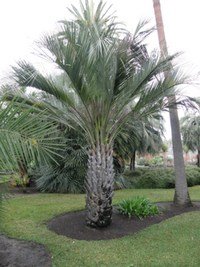
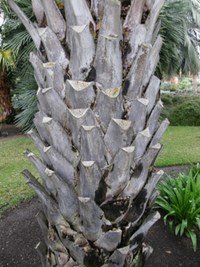
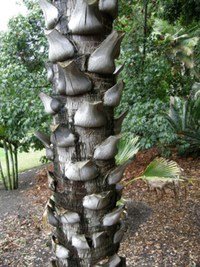
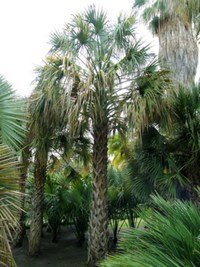
Trimming branches can alsoe reveal interesting and ornamental retained leaf patterns, as seen in these Butias, the Livistona benthamii and the Sabal uresana
Some palms are self cleaning, meaning that the old leaves fall off once they die. Other palms tend to retain a ‘petticoat' of dead palms that surround the trunk to varying degrees. And some palms I call ‘semi-self-cleaners. These are really self cleaning palms that tend to have 0-4 dead leaves hanging on at any one time before they finally fall to the ground. Examples of self cleaning palms include King palms (Archontophoenix species), Kentia palms (Howeas), Jubaeas and Chamadoreas. These palms never need to be trimmed as the dead leaves fall soon after dying. That does not keep some from pruning them, however. Palms that form a petticoat include Mexican Fan Palms (Washingtonias) (the most common of all the landscape palms), Chinese Windmill Palms (Trachycarpus), Mediterranean Fan Palms (Chamaerops), most Sabals and some Braheas. These palms develop thick masses of dead leaves that can be unsightly and provide haven for rats, owls and pigeons, so are normally pruned off. Palms that fit in the semi-self-cleaning category include Queen palms, Phoenix, some Braheas and Bismarckias. These are palms that if one never pruned will still have a bare trunk with maybe 0-4 or more dead leaves (up to 30 or more in Phoenix) hanging at any one time, but the leaves will not form a significant petticoat of dead fronds (they fall off before that point).
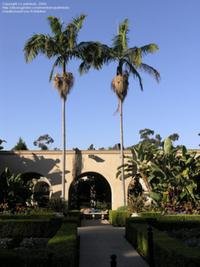
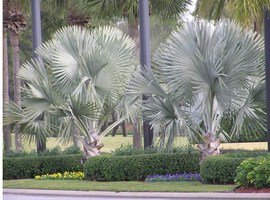
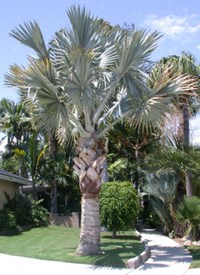
Archontophoenix (like these King Palms) are self cleaning palms. Also Bismarckias are, too, but when young, pruning may be necessary to keep the lowest leaves out of the way
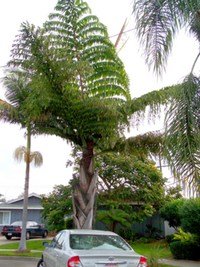
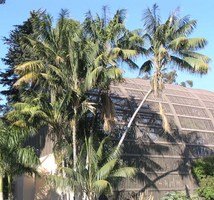
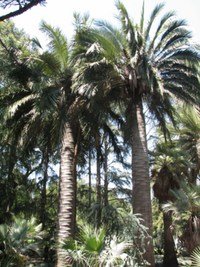
3 more self cleaning species: Caryota sp (gigas in photo... though pruned to keep lowest leaves from public), Howea forsteriana (Kentia Palms) and Jubaeas
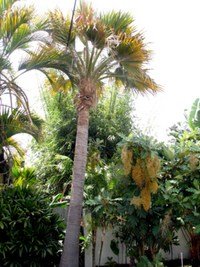

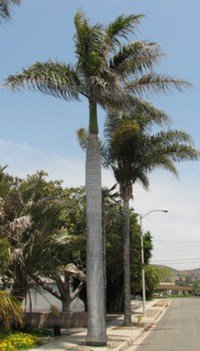
Pritchardia species, Majesty palms (Ravenea rivularis) and Royal Palms (Roystonea sp.) are also self cleaners
Here are some general rules to follow when pruning palms:
•1. 1. Do not prune self cleaning palms. These palms are much more likely to suffer from the premature loss of leaves, and it makes no economic sense to trim these palms as well. However, some palms that have very large heavy leaves (like Royal Palms (Roystoneas), Chilean Wine palms (Jubaeas) and exceptionally old, large King palms (Archontophoenix) can be potential hazards and subsequent legal concerns if public trees are dropping 50 lbs leaves on the pedestrians and automobiles below). So if absolutely necessary, trim the oldest leaves only, preferably as they are turning yellow (dying). Obviously a tall, old Jubaea would have to be pruned monthly then to remove the older fronds, so this might be an exception to this rule.
•2. 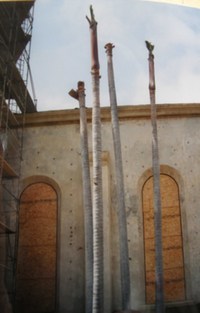
Not only should one not trim King palms, these were trimmed to the point of extinction- I seriously doubt the owners of these palms wanted them all killed, but they have been but such extreme trimming
2. When pruning fan palms and Phoenix palms never prune past the horizontal (don't prune any leaves that are growing above horizontal) as this will severely weaken the palm. However, it is a very common and almost ‘accepted' practice to over-prune Washingtonia and Phoenix palms, sometimes to the point of being ridiculous. Not only is it an eye sore to see these horrifically pruned trees, but leaving only several leaves at the top of the palm (sometimes called a hurricane or rooster-tail cut) allows it to be fatally damaged by winds, or cause the trunk to be narrowed at that point (and forever weakened), and forces the entire palm to feed itself on just the food produced by a few fronds. Occasionally this excessive pruning and resultant stress upon the palm will result in a dead palm which far outweighs the savings seen by getting away with pruning the palms less often (presumably the only reason I can give for such a horrible pruning practice). But even if the palm survives this excessive pruning, it is forced to use its reserves stored within the trunk tissue and after several years this gradually leads to a narrowing of the trunk, predisposing the tree to wind damage, fracture and loss of life. The pruning of fan palms (and Phoenix) at the horizontal is a compromise between attempting to prune only the number of leaves the palm can produce between pruning times and reducing the frequency of having to prune the palms at all for economic reasons.
•3. 
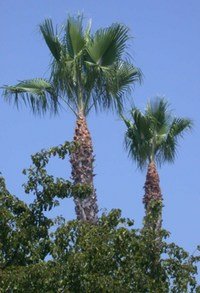

In the first photo above, you can see the unpruned palms on the left, and the pruned ones on the right- too extreme! Though they will probably survive it. Second phots is a close up of some Washingtonias pruned far beyond the horizontal which is NOT good pruning practice. Last photo shows a row of Washingtonia filiferis hacked to only 3-4 leaves each. If one drives by this row of palms today in Simi Valley, California, one will notice many deceased and missing palms, probably some from these poor pruning practices
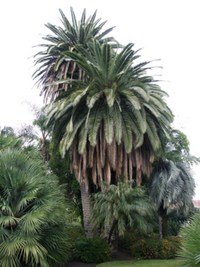
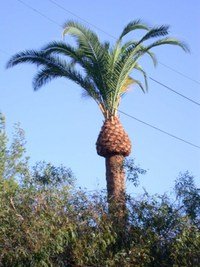
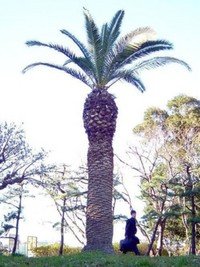
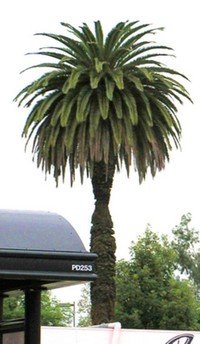
Unpruned Phoenix canariensis with minimal skirt; Way overpruned Phoenix canariensis. Continual pruning like this will lead to pinching of the trunk (seen in photo on right); middle photo by Yoshida
3. Do not use cleats or other damaging footwear when climbing palms. Palms are not like angiosperm trees and cannot heal over wounds made from such injuries. A hole in a palm will remain forever, and be a permanent scar as well as a source for pathogens to enter. Palms are best pruned with the use of cranes or other equipment that allows the pruner to stand next to the crown and securely prune with little danger of falling and injuring himself, as well as the palm. Uninsured palm trimmers that physically climb your trees to prune them put you at a serious liability risk.
•4. 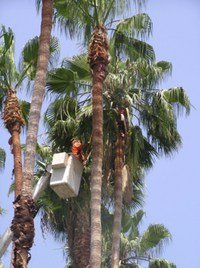
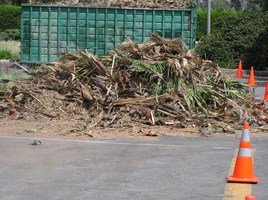
Washingtonias pruned using a cherry picker, and the debris below (mostly cut boots with a few leaves)
4. Always use well-cleaned and/or sterilized pruning equipment. Many of the Canary Island Date palms in southern California are dying of fusarium wilt, a fungal disease spread from palm to palm by the careless use of dirty/contaminated pruning equipment.
•5. 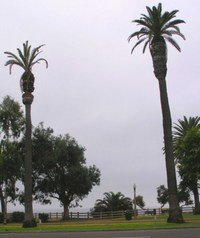
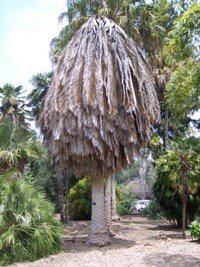
Phoenix canariensis dying of fusarium wilt spread by contaminated equipment; compare to palm that died of natural causes (not overpruned obviously)
5. Never top palms. This may seem like an obvious rule to follow, but I am repeatedly surprised by the numbers of tall, beautiful palms that just end in a stump, usually near power lines or some other structure one obviously did not want the palm to grow taller than. These palms are often pruned by ignorant landscapers that think topping a palm is like topping any other tree, and will force the palm to stay shorter. Well, it will, but by killing it and making it a dead stump. No palms can tolerate being topped.
•6. 6. While pruning palms, always remove the inflorescences. This will help the palm tolerate some excessive loss of green leaves as well as put more of its energy into growing and maybe improve its overall health. Obviously this means NOT removing inflorescences of palms that are self cleaning, as those palms do not benefit from the loss of their flowers. Almost all self cleaning palms that are commonly used as landscape palms have relatively insignificant inflorescences in terms of size, fruit production and energy loss to the palm.
•7. 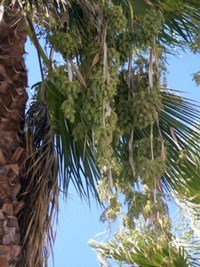 Washingtonia filifera inflorescence- should be removed when pruning
Washingtonia filifera inflorescence- should be removed when pruning
7. Do not prune palms that are potassium deficient. These palms have typical yellow spotting on the oldest leaves (Sabal causarium is a common species that suffers this condition in California). Cutting off these yellowing leaves make temporarily make the palm look healthier, but it will force the leaves now left to start showing signs of potassium depletion, further weakening the palm. Instead supply the palm with extra potassium and put off any pruning for at least a year or more.
•8. 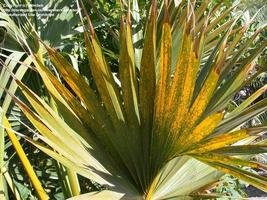 Sabal causiarum leaf showing potassium deficiency- do not prune this leaf
Sabal causiarum leaf showing potassium deficiency- do not prune this leaf
8. Try to avoid pruning for cosmetic purposes, though that is a pretty tough rule to follow. And frankly, I like the looks of some pruned palms over that of un-pruned ones (eg. a well-pruned Chamaerops can have a wonderful ornamental appearance an un-pruned plant cannot approach). And Phoenix pruned so that some of the leafbases are left behind forming that interesting ‘pineapple' look are a nice look, as long as they are not over-pruned (above the horizontal).
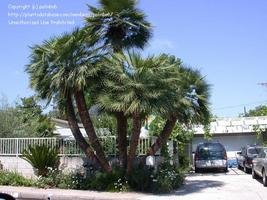
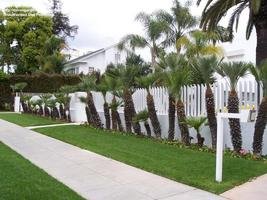
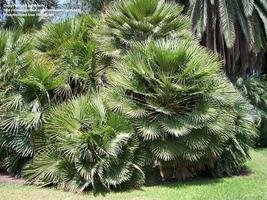
Chamaerops humilis examples, showing pruned palm, over-pruned palms and non-pruned palm
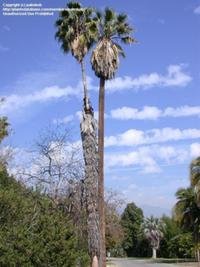
Chamaerops palm pruned carefully to look like a bonsai
The actual pruning of palms is not conceptually difficult but to prune some palms well can require a good deal of skill, care and strength as well as something like a crane or cherry picker. Trimming Washingtonia palms can be both dangerous and challenging as many of these are 50'-100' tall and have dangerous sharp, saw-like petiolar teeth that can easily rip the flesh or catch on clothing throwing off ones balance. For pruning these trees to a smooth trunk requires an additional pulling or sawing off of the ‘boots' (retained leaf bases). Very old palms will often start stripping themselves of these old leaf bases, and many will lose these in storms or high winds creating huge messes below. But to cut these off requires a steady hand, a very sharp linoleum saw, or chainsaw. Chainsawing off these boots carelessly can easily result in marring or severely damaging the trunks, in turn resulting in a weakened or badly injured tree. This is a job best left to professionals.

Washingtonia robusta on left and Washingtonia filiferi on right, showing their natural loss of leaves. The W robusta is more likely to keep a full peticoat, but eventually these fronds will be lost naturally as one can see near the top. The W filiferi is a semi-self-cleaning palm having lost all but the most recently deceased leaves near the top of the palm
Pruning some palms can also require a lot of care and skill, not just to get the trunks clean, or even carved to look like a sculpture, but to avoid being seriously injured by the sharp leaf base spines or petiolar teeth. One Phoenix leaf can have 20 to 50 of these deadly skewers pointing in all directions making pruning the leaf off near these spines a real challenge. These are not only a danger to ones skin, but eyes can easily be jabbed and blinded by these deadly spikes. Again, this is a job probably best left to professionals. Remember to use only clean/sterile pruning tools when cutting Phoenix leaves!
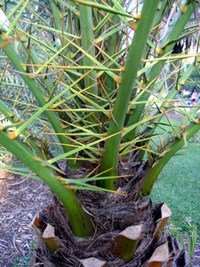
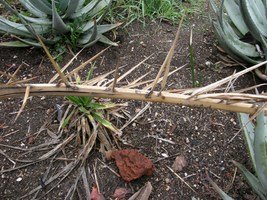
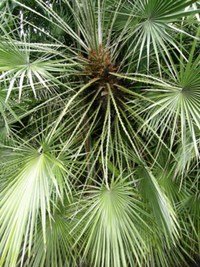
Phoenix theophrastii showing the typical dangerous Phoenix leaf-base spines, and spines on fallen Phoenix canariensis leaf; last photo shows Chamaerops leaves and the incredibly sharp petiolar teeth
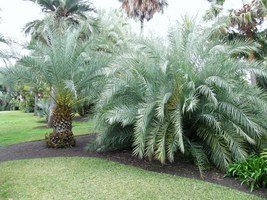
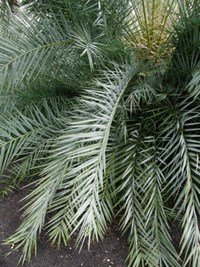
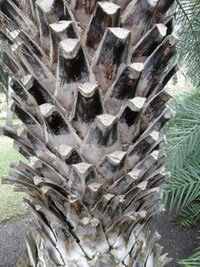
Phoenix theophrastiis, pruned and unpruned; these palms not only have deadly spines along the leaf bases, but the leaves themselves are extremely hazardous as each leaflet ends in a sharp, stiff barb; look of trunk after trimmed back- fairly ornamental and worth the effort
The pruning of other palms simply requires a sharp pruning saw and a steady hand. Cutting off large, heavy fronds should be done initially from below, and then finishing above. The initial bottom cut keeps the falling leaf from tearing off a long strip of tissue down the trunk prior to making a clean cut of the leaf (similar pruning recommendations exist for cutting branches on other trees as well).
Notes on other palms:
Queen palms do not need to be pruned as they are semi-self-cleaning palms. However un-pruned Queen Palms tend to have at least 2-4 dead leaves hanging now and then and some consider these leaves unsightly. But cutting these palms back to a rooster tail as is commonly done in landscaping is a horrific and unsightly practice. Queen Palms are potentially beautiful palms and cutting them like this makes them weak, anemic-looking and gives them a bad name. Just don't do it!!
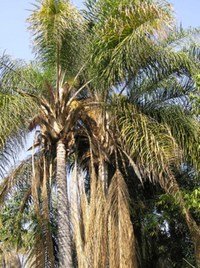
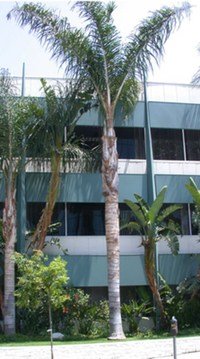
Queen palm with some dead fronds that probably should be pruned off. But the Queen on the right is unecessarily pruned severely
Chamaerops palms can be difficult palms to prune as they have incredibly sharp spines along their wispy petioles that can do severe damage to face and arms if one is not careful. And these palms quickly develop into painful thickets if one does not keep up with the pruning regularly. A thicket look, if what one is going for, is fine, but most prefer a more kempt look for this species. Just be careful. As these are suckering palms, one need often also prune the suckers themselves off. The palm tolerates this well in most cases. Cut the trunk/suckers back as close as possible to their origins or one will end up with some unsightly dead stumps.
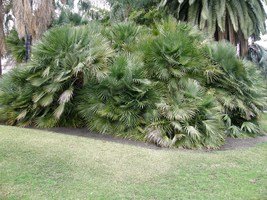
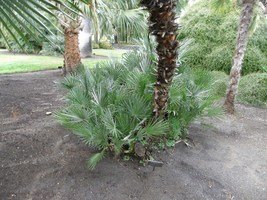
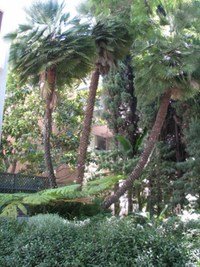
Unpruned Chamaerops can be a dangerous challenge to begin pruning; pruned palm with tyical mass of new growth below that requires continuous work; very large Chamaerops specimen pruned back to only 3 trunks, though it is constantly making more
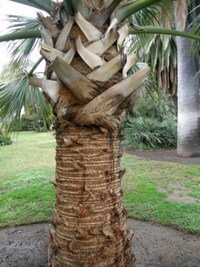
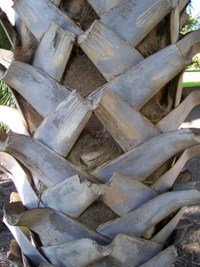
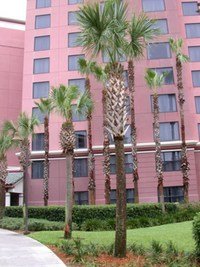
Sabal palms can handle more pruning abuse than most genera- first photo shows where boots (leaf bases) have simply been pulled off the trunk; close up of pruned leaf bases, and group of Sabal palmettos given rooster-tail pruning to almost 3-4 leaves only... though this is still not recommended, these palms tolerate this surprisingly well
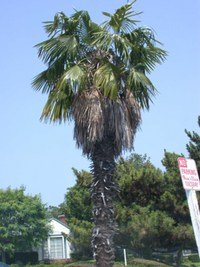
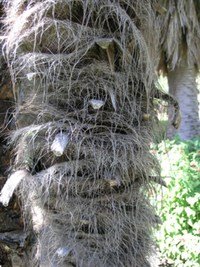
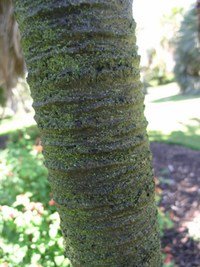
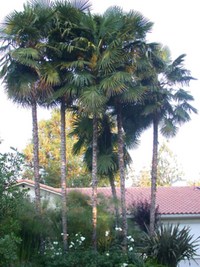
Trachycarpus palms are relatively simple palms to prune and offer few challenges, but sometimes one may one to remove the fuzzy trunk fiber, a very slow, tedious process that can easily result in damage to the trunk. This is another job probably best lef to professinals
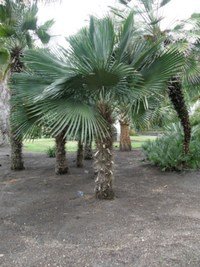
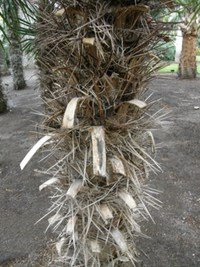
Some palms like this Trithrinax brasiliensis require special consideration when pruning as not only does if have sharp spines along the petioles, but the trunk itself is heavily armed and dangerous, make close pruning difficult and painful
Palm pruning is sometimes a necessary evil, and if done properly and judiciously can leave the palms looking attractive as well as healthy. Many palms can live over 100 years, but their lives will can easily be ‘cut short' so to speak by sloppy or unscrupulous pruning. Be careful!
Copyright © www.100flowers.win Botanic Garden All Rights Reserved